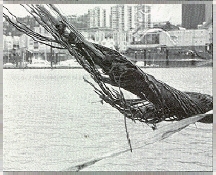 More and more news outlets are starting to pick up on the story of the recently damaged submarine cables. Information about the damages to the cables has been garbled and determining those basic necessities of (responsible) reporting has become difficult. Who, what, where and when? Reports of the numbers of cables affected are now ranging from 5 cuts to 9 cuts. Most major news outlets are sitting in the 4-5 range while others (usually a bit more independent) are playing in the higher numbers. There are acronyms a plenty and information strewn from message boards to major news sources.
More and more news outlets are starting to pick up on the story of the recently damaged submarine cables. Information about the damages to the cables has been garbled and determining those basic necessities of (responsible) reporting has become difficult. Who, what, where and when? Reports of the numbers of cables affected are now ranging from 5 cuts to 9 cuts. Most major news outlets are sitting in the 4-5 range while others (usually a bit more independent) are playing in the higher numbers. There are acronyms a plenty and information strewn from message boards to major news sources.
As a concerned citizen I found that it was very important to trace these stories to their sources and do my best to give you the most accurate information on what appears to have happened in the past couple of weeks underneath the waters covering most of this planet we call home.
I hope that I can help to shed some light on this subject and help to ease rumors and misinformation that seems to run rampant when events like this occur. So, in good reporting fashion, we will split up the cable crisis into an easy to understand format which will, (hopefully) help for those of you still swimming through the mess that has been made.
Who
There have been a number of reports with estimates of the number of people affected. The following table provides some of those numbers. Just click on the number for the source:
| India | 60,000,000 |
| Pakistan | 12,000,000 |
| Egypt | 6,000,000 |
| Saudi Arabia | 4,700,000 |
| Iran | 4,000,000 |
| United Arab Emirates | 1,700,000 |
| Algeria | 1,000,000 |
| Sudan | 1,000,000 |
| Lebanon | 400,000 |
| Syria | 300,000 |
| Total | 91,100,000 |
| Countries also affected | Bahrain, Bangladesh, Maldives |
Renysys.com has offered some excellent technical information into the countries affected by the Mediterranean cable breaks. Who is Renysys? From their website:
“Our optimized algorithms gather real-time data from the Internet backbone, around-the-clock. We analyze the major Internet transit providers and compile objective, comprehensive information into real-world statistics on regional trends and route selection in the retail, wholesale, and backbone markets.”
You can check additional technical information by visiting their blog and looking in their archives.
What
The submarine cables, that you are probably aware of by now, are communications lines which help transfer data, such as: voice, internet & multimedia, long distances underneath the seas and oceans covering this planet. Laying these cables is no small task. The amount of cable required and the sheer size and weight of the cables call for some of the larger ships on the sea. This is a photo from Wikipedia of the René Descartes (though examples of other ships can be found here and here):
The maelstrom of stories falling around the internet are all about damages that have occurred along the cables. There have been a range of speculations as to how the cables may have been damaged. These speculations range from collision with anchors by ships in a storm, to international conflicts.
There are three major submarine cables that have been damaged. The cables can be easily confused given the spread out nature of the news sources of the internet and the number of acronyms that there are. Here are the three cables, along with the links to the official websites, in question:
- SEA-ME-WE 4: the “South East-Asia-Middle East-West Europe 4“. This cable stretches from France to Malaysia.
- FALCON: the “Flag Acatel-Lucent Optical Network.” This cable stretches from the tip of the Suez canal in Egypt, around into the Persian Gulf, across the Indian Ocean, and down to Malaysia.
- FEA: the “Flag Europe Asia“. This cable stretches from Europe all the way to the Eastern side of Asia.
These are the cables that were damaged in just a few days. Repairing the cables can take weeks. In 2006 we were privy to an unfortunate example of how these cables can be damaged when the country of Taiwan was shocked by the highly destructive Hengchun earthquake, and the aftershocks that followed. Some sources have, unfortunately, pointed to this as an example of just how often underwater cables are damaged. Alcatel-Lucent has a pretty good animation of the repair process (they are also the source for the maps on this page):
No major natural disaster can be blamed for the recent internet outages — though there are those who have attributed the damages to ships dragging their anchors along the bottom of the oceans in inclement weather (not a disaster, albeit natural).
When & Where
As far as this author can tell, there have been 9 cuts that have been reported on, at least, three different days.
- Day 1 – January 23rd, 2008 – 1st cut – FALCON near Bandar Abbas, Iran
Bijal Sanghani, the Sr. IP Technical Support Engineer of the Technical Services Group of FLAG Telecom wrote, in an repair schedule e-mail, that there were damages on both of the FALCON cables leaving Bandar Abbas, Iran. One was listed as February 1st. This is the other:
“FALCON Segment 7b (Bandra Abbas – Al Seeb) – E-Marine continues to await the permit to enter the Iranian waters and current forecast for the ship to start a work is around 19th February.”
The Khaleej Times also reports that Mahesh Jaishanker, an executive director in business development and marketing for du (a telecom company in the United Arab Emirates) said that:
“The first cut in the undersea Internet cable occurred on January 23, in the Flag Telcoms FALCON submarine cable which was not reported. This has not been repaired yet and the cause remains unknown, explained Jaishanker.”
David Vorster, a forecaster from Gulfnews said of the weather on the 23rd:
“”The weather is nothing much to write about,” […] adding that the conditions are normal for this time of the year.”
- Day 2 – January 30th – 2nd, 3rd & 4th Cuts – SEA-ME-WE 4 and FEA in the Mediterranean
Although the times for the cuts were not recorded, the data from Renesys recorded major events occurring in the Mediterranean area at (UTC) 4:30am, 6:00am and 8:00am with another event (quite possibly re-routing) occurring at 13:00pm:
The owners of the cables only reported the damages outside of Alexandria, Egypt. However, the New York Times reported that telecommunications officers stated a cable was damaged
“…in the waters off Marseille, France.”
This corresponds with the spokesman for Flag Telecom who, speaking on the Alexandria damages, told The Register:
“One of the ship’s anchors cut our cable but there are multiple cuts – we’re not the only company having problems.”
The cut outside of Marseille would also explain the loss of connection experienced in Algeria, across the Mediterranean, from France.
The other two cuts were outside of Alexandria, Egypt. Flag Telecom acknowledged FEA was damaged 8.3km off the coast. The second, SEA-ME-WE 4, was reported damaged 25km off the coast by the Associated Press Pakistan and written about at Netxpress Online.
- Day 3 – February 1st, 2008 – 5th, 6th, 7th & 8th Cuts – FALCON (& possibly FEA) in the Suez Canal and the Persian Gulf
Cut number 5, in the Persian Gulf, was reported by Qatar Telecom. It was reported to be between Haloul Island, Qatar and Omas Das Island, UAE. Cut number 6 was reported on the link that connects Dubai, UAE with Oman. It was said that this one was 56km off of the coast of Dubai.
Cut number 7 was reported by a Flag official who did not want to be named. They told Zaywa Dow Jones that there was a cut on a
“…fibre optic cable running through the Suez to Sri Lanka [on] Friday.”
The only Flag line that runs from the Suez out towards Sri Lanka is Flag Europe Asia. However, the article says that the official was talking about FALCON (which does not run to Sri Lanka, but does run out the Suez Canal). Therefore, it is safe to say that either FEA or FALCON was the cable they were talking about:
Cut number 8 was back at Bandar-Abbas Iran. This time, it was on the other segment of the FALCON cable as reported by the same repair email from earlier:
“FALCON Segment 7a – Fault 1st February between BND (Bandar Abbas, Iran) and KWI (Kuwait), we are waiting for ship to go out and it maybe fixed before going out the fault on 7b – to be confirmed.”
- Reported February 5th – 9th Cut – FEA near Penang, Malaysia
The last cut does not have an accurate date associated with it. However, it was reported along with the other cuts that occurred on February 1st. This particular cut was 28km out from Penang, Malaysia. It was first reported in the Khaleej Times:
“These are SeaMeWe-4 (South East Asia-Middle East-Western Europe-4) near Penang, Malaysia…”
The damage was also reported in the repair email that was sent by Flag:
“FEA Segment M – The cable ship CS Asean Restorer has been booked for this repair. It is currently out on an APCN repair and with current plan will be ready to start any work on our cable on or after 11th Feb. We have the OTDR traces from Penang and see that the fault is around 28km out from the station.”
The Asean Restorer was also out near that area repairing submarine cables in September and November of 2007.
Well, there you have it: the most complete guide to the 2008 internet outage available. I hope that this article was successful in helpful you understand the submarine cables mess that has been created on the internet. Now if only we could get the “Why” portion of this guide completed. At least now you have the facts. Maybe now, others can start working on why this may have occurred.
If you liked this post, be sure to subscribe to my RSS feed and check out my other posts on the subject as well.
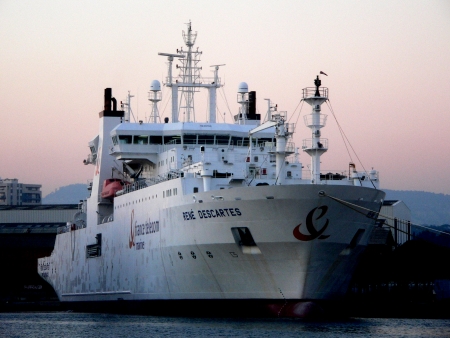
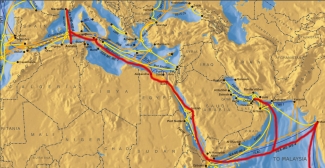
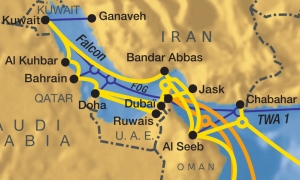
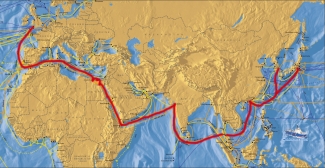
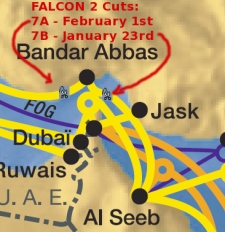
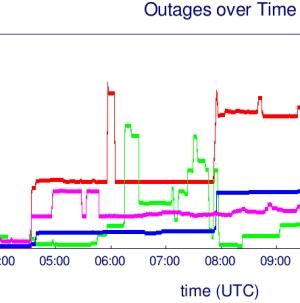
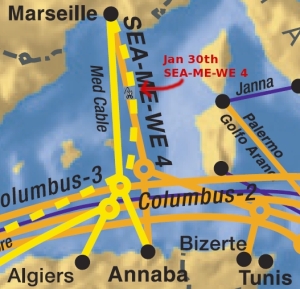
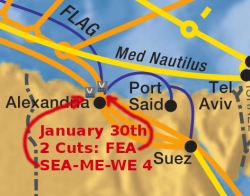

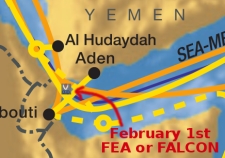
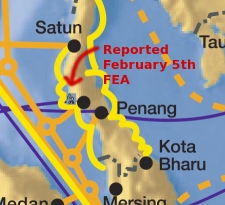
Pingback: Szymon Nitka()
Pingback: Avería en cable submarino provoca problemas en Asia y Oriente Medio()
Pingback: Avería en cable submarino causa problemas de servicio en Asia y Oriente Medio ¶ Good news everyone!()
Pingback: Avería en cable submarino causa problemas de servicio en Asia y Oriente Medio | My Daily Feeds()
Pingback: Avería en cable submarino causa problemas de servicio en Asia y Oriente Medio | El Tenanpa()
Pingback: Avería en cable submarino causa problemas de servicio en Asia y Oriente Medio - Marketing digital : Marketing digital()
Pingback: Avería en cable submarino causa problemas de servicio en Asia y Oriente Medio | MiMonteria()
Pingback: Avería en cable submarino causa problemas de servicio en Asia y Oriente Medio | TECNOLOGIA Y NOTICIAS()
Pingback: faluu.com » Blog Archive » Avería en cable submarino causa problemas de servicio en Asia y Oriente Medio()
Pingback: Avería en cable submarino causa problemas de servicio en Asia y Oriente Medio | 18minutos()
Pingback: Avería en cable submarino causa problemas de servicio en Asia y Oriente Medio | Reparacion Ordenadores Cantabria()
Pingback: Tecno NV » Avería en cable submarino causa problemas de servicio en Asia y Oriente Medio()
Pingback: Avería en cable submarino causa problemas de servicio en Asia y Oriente Medio | iMapas()
Pingback: Avería en cable submarino causa problemas de servicio en Asia y Oriente Medio | EmaCorp News()